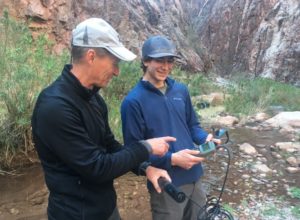 The primitive trail is steep, the prickly desert plants unforgiving and the rushing spring-fed creeks are cold. Really cold. Twenty miles in from the South Rim, hydrologists traverse challenging Grand Canyon backcountry with the ease of young mountain goats. Their job is to test the groundwater in the aquifer as it emerges and cascades down sheer rock canyon walls, or seeps from heavily vegetated slopes.
The primitive trail is steep, the prickly desert plants unforgiving and the rushing spring-fed creeks are cold. Really cold. Twenty miles in from the South Rim, hydrologists traverse challenging Grand Canyon backcountry with the ease of young mountain goats. Their job is to test the groundwater in the aquifer as it emerges and cascades down sheer rock canyon walls, or seeps from heavily vegetated slopes.
No one knows how much water exists in the cavernous Redwall-Muav Aquifer, but Northern Arizona University hydrogeologist Abe Springer, Ph.D., and his team are trying to find out. The water – some of it fresh from recent storms, some of it hundreds of thousands of years old – makes up 100 percent of the water supply that serves six million visitors and 300,000 residents at the Grand Canyon each year.
Variations in the quantity and quality of the water is important information for the National Park Service, which is sponsoring the study, especially in the face of a warming, drying climate. Springer says the future security of the park’s water supply relies on a dependable source of water flowing from the aquifer and springs.
“Since the mid ‘90s, we’ve been in a very dry climate phase and that has affected the amount of recharge to aquifers, which has an effect on the amount of water that can discharge from springs. We’ve seen some springs in Northern Arizona that have been drying out from this recent climate change. But because we don’t have long-term measurements, we don’t know if that’s happened before.”
For the past three years, Springer and researcher Stefan Christie have been monitoring the canyon’s springs and testing the water’s physical properties for variations in chemistry, temperature, turbidity and volume in response to changes in climate.
“Since our aquifer source is limestone, you get a lot of calcium carbonate deposits in the streambed and on our instruments and it can kind of gunk them up,” said Christie as he pulls gauges from a chilly stream near Phantom Ranch. “So, we’ve got to come down and make sure they are clean and working properly.”
Miles farther down the canyon, Springer climbs to the source of fragrant Mint Spring along Bright Angel Creek. “Any spring is a great window into an aquifer,” he said. “Since we don’t have wells or other ways to access the aquifer where the water meets land surface, it’s a great place for us to sample the groundwater.”
Springer, a long-time friend of the canyon and hiking geology book, explains that Mint Spring comes out of the Grand Canyon Super Group. “These are some rocks that are about 750 million years old. So, to get to this depth in the canyon, the water has got to seep down through about 4,000 feet of rocks.”
He calls Grand Canyon National Park a cave and karst park. “Most people don’t know this, but Grand Canyon has more caves than any other national park. Karst describes a type of land topography created where there are limestone rocks and they dissolve. It forms a lot of closed depressions where runoff doesn’t leave through streams, it flows into a depression and recharges the aquifer.”
Some of the natural pipes and sinkholes under the rim go down 3,000 vertical feet. “We don’t have any type of method to observe those pipes, no imaging, no CAT scans, no other method. The only way we can know exactly where the water goes is to introduce a tracer into the water and see where it goes and how quickly it goes.”
Last year, Grand Canyon scientists used a food-grade dye to trace the water’s path. They wanted to know which sources connect to what discharge points. The results were surprising. “We did not see the dyes at the expected springs. Instead we found them at springs that were very unexpected places – far to the west and far to the east. The results of that study tell us how complex this deep aquifer is and how it’s connected to the surface.”
About 3,500 feet below the North Rim, Roaring Springs pours out of a complex cave system. It is the source for the trans-canyon water supply line that was built in the ‘60s. To monitor the water at its source and access their data, the researchers rope-climb up a side canyon and wade through waist-high water.
“That trans-canyon water delivery system has outlived its useful design life. It breaks frequently, it’s difficult to maintain, and the park is struggling to provide a consistent reliable source of water.” So, he explains, the Park Service is considering moving the intake from Roaring Springs to the spring-fed stream where it enters the Colorado River. This would result in abandoning eight miles of aging, breaking pipeline.
Springer’s studies will help park officials decide where the water will come from in the future that will satisfy the thirst of Grand Canyon’s visitors, residents and businesses. FBN
By Bonnie Stevens, FBN
Photo captions:
PAGE 1 caption: NAU hydrogeologist Abe Springer and student researcher Zev Axler hike for miles and days in Grand Canyon’s backcountry to test springs for variations in quality and quantity. Springer is a professor in School of Earth Sciences and Environmental Sustainability.
Photo by Bonnie Stevens





